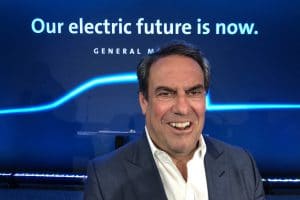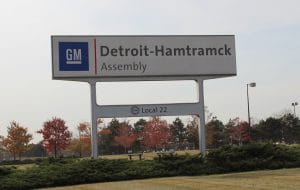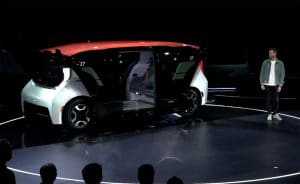
GM President Mark Reuss discussed the company’s plans to make its Detroit-Hamtramck plant the center of its EV production.
General Motors will invest $2.2 billion in its 35-year-old Detroit-Hamtramck Assembly Plant, transforming an aged factory that had been set to close into one of the most modern in its global network.
The transformation will be completed next year, GM President Mark Reuss said Monday, when GM begins rolling out an all-electric pickup. It will be the centerpiece of a Super Bowl ad next month and is widely expected to be dubbed the “Hummer,” picking up on the brand name abandoned by GM after it emerged from bankruptcy a decade ago. What is locally known as the “Poletown Plant” also will build the driverless Cruise Origin shuttle that debuted last week, along with a variety of other pickups and SUVs, said Reuss.
The plant will be capable of using an extremely flexible vehicle “architecture,” said Reuss, industry-speak for its underlying platform. It will allow the automaker to produce multiple products “for multiple brands, with multiple variants, with multiple customers (offering) different ranges of performance at different price points to meet customers wherever they are.”
(GM to builds Cruise Origin, electric pickup and assortment of other EVs in Detroit plant)
Originally put up to build Cadillacs, the Detroit-Hamtramck assembly plant has struggled in recent years, a victim of low demand for the products it assembled. It was one of three North American assembly plants GM said in November 2018 that it would close. But the automaker reversed its decision after deciding to ramp up its commitment to battery-electric cars.

Reuss greets Michigan Lt. Governor Garlin Gilchrist and Michigan Governor Gretchen Whitmer at the GM Detroit- Hamtramck (MI) Assembly Plant.
“In November 2018, a lot of us didn’t think this day was coming,” said Detroit Mayor Mike Duggan, during a news conference at the Poletown plant on Monday morning. “It’s not often you see people reverse decisions they’re announced.”
The reversal was a matter of timing. GM, according to CEO Mary Barra, is “on a path to an all-electric future,” and expects to have at least 20 battery models in showrooms by 2023. Some of those will be produced at a factory in Orion Township, Michigan already assembling the Chevrolet Bolt EV. That includes an electric Cadillac SUV. The Detroit-Hamtramck plan will assemble larger pickups, SUVs, crossovers and other vehicles, including the Hummer pickup and the Cruise Origin.
The latter vehicle is a fully driverless shuttle developed for Cruise LLC, a San Francisco-based start-up that plans to launch an autonomous ride-share service. Additional versions of the Origin will be aimed at delivery services. The Origin will go into production in early 2022, following the launch of the Hummer pickup, according to Reuss.
GM has offered relatively few other details about its battery-car plans, though the carmaker also has confirmed it will build an all-electric crossover for the Cadillac brand that it is expected to unveil this spring.

GM’s Detroit-Hamtramck Assembly plant will become the primary site for production of the company’s electric vehicles, starting with a new electric pickup.
(UAW workers ratify new GM contract)
The $2.2 billion that GM will spend on the Detroit-Hamtramck plant is part of a broader investment of $3 billion authorized as part of the contract it negotiated last autumn with the United Auto Workers union. That includes a number of other projects supporting the automaker’s aggressive plan to “electrify” its vehicles. Late last year it said it would set up a factory in Lordstown, Ohio, to build batteries as part of a joint venture with South Korea’s LG Chem worth $2.3 billion.
In all, Reuss told TheDetroitBureau.com after Monday’s news conference that GM has “easily” committed to spending more than $10 billion on its battery-car program, with more investments to follow as it adds more product.
The carmaker is expected to add more production capacity, according to several analysts, with a site in China, GM’s largest market by sales, likely to get at least one plant. China also has become the world’s largest market for battery-electric vehicles – though sales did dip in 2019 due to cuts in government incentives.

The Cruise Origin has no steering wheel or pedals, room for six and will call San Francisco its home to start. GM will build it at the Detroit-Hamtramck plant.
GM is by no means the only automaker investing heavily in battery-cars. Volkswagen has committed more than $12 billion so far, Ford more than $11 billion. By mid-decade, virtually every automaker is expected to offer a mix of hybrids and all-electric vehicles – though some, including GM, have said they will focus exclusively on BEVs.
The big question is whether consumers will go along. While battery-car sales did surge worldwide in 2018, demand leveled out last year, the U.S. market, in particular, rising barely 3% overall. Nonetheless, industry analysts are anticipating the growth rate will accelerate rapidly as more products, such as the Hummer pickup and Cadillac SUV – as well as Ford’s Mustang Mach-E and the Tesla Model Y come to market. A new study by the Boston Consulting Group forecasts battery-based vehicles will account for 51% of the U.S. auto market by 2030 – though that covers everything from hybrids to BEVs.
(Return of the Hummer? Electric pickup could debut during Super Bowl)
“Word-of-mouth will be critical” to increasing demand for EVs, Reuss said, noting studies showing extremely high satisfaction rates among owners. Equally important, however, battery costs are tumbling, even as range is growing longer. And the network of public charging stations is rapidly expanding.
